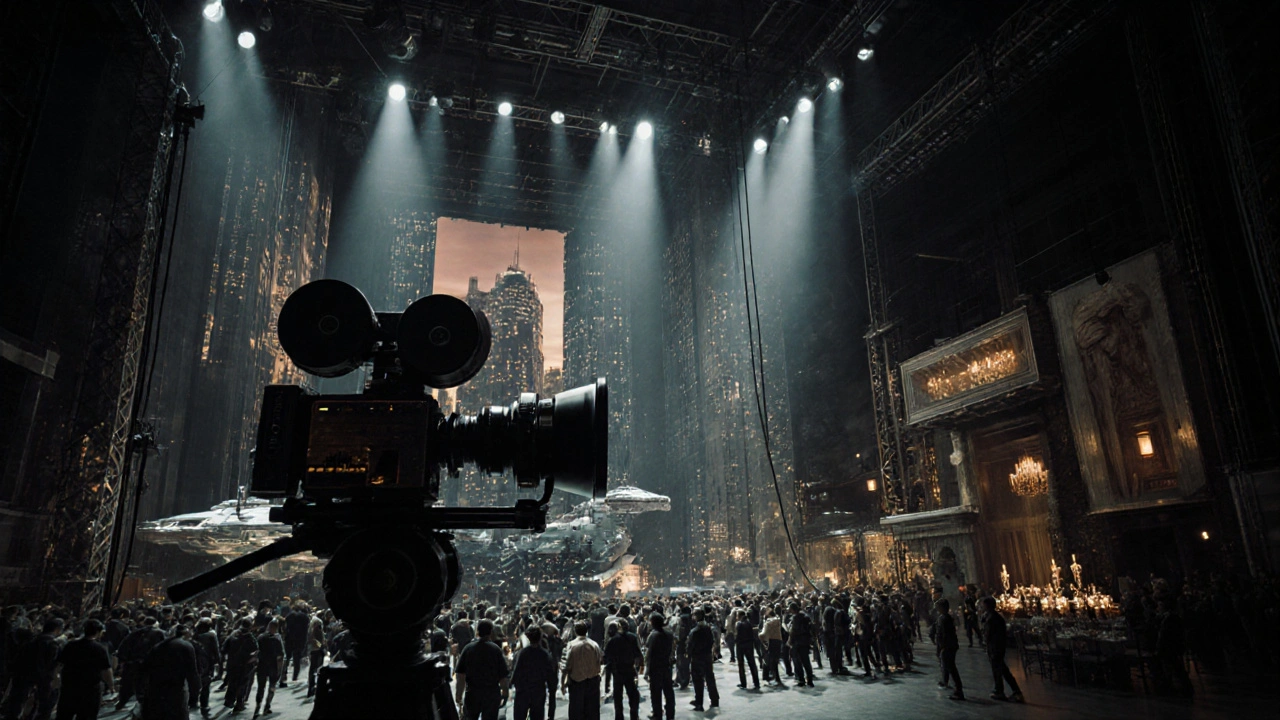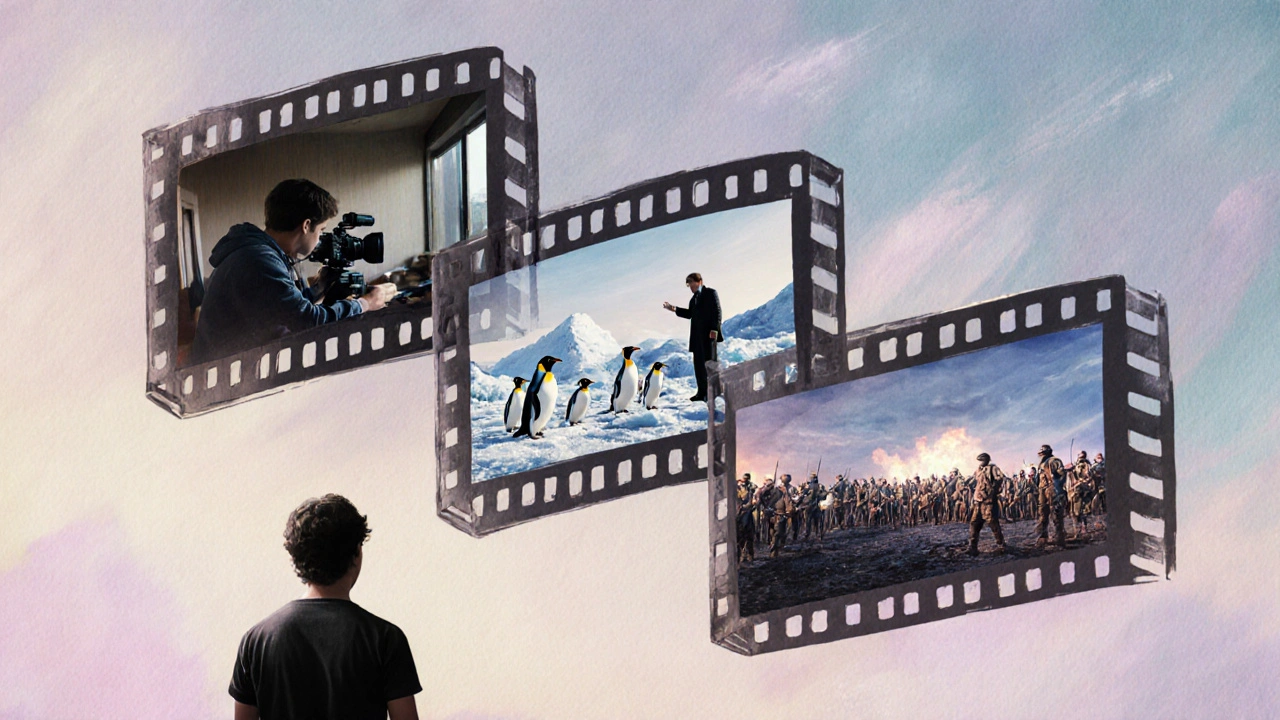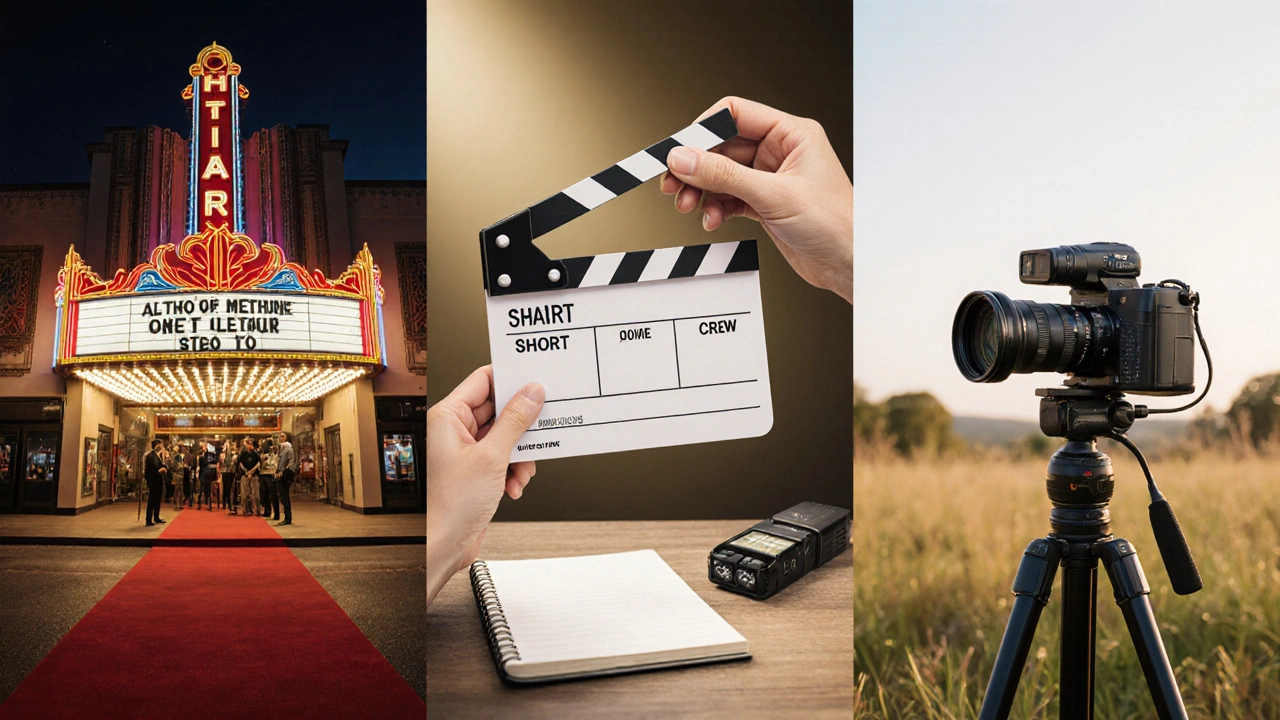Film Type Calculator
Film Type Calculator
Enter a film's runtime and budget to determine its type. The tool is based on industry-standard parameters for feature films, short films, and documentaries.
Enter runtime and budget to see the film type.
Ever wondered why people keep talking about movies as if they fall into neat boxes? Most of the time, those boxes are types of movies rather than genres like horror or romance. Understanding the three major types helps you pick what to watch, decide what to produce, or simply appreciate film language a bit more.
What "type" Really Means in Film Talk
When we say "type" we’re not classifying story content; we’re describing the form and intent behind a moving‑image work. A movie’s type tells you its typical length, production scale, distribution path, and the audience experience it aims for. The three most widely recognized types are:
- Feature film
- Short film
- Documentary film
Each type has its own history, budget range, and creative conventions.
Feature film is a full‑length narrative designed for theatrical release
A feature film typically runs anywhere from 80 to 180 minutes. The magic number in the industry is 90 minutes, but blockbuster epics often push past the three‑hour mark. Features command the biggest budgets-Hollywood’s biggest productions regularly exceed $200million, while independent features can be made for under $1million.
Key attributes:
- Runtime: 80‑180minutes
- Budget: $1million-$300million+
- Distribution: Theatrical windows, later streaming or TV
- Purpose: Entertainment, storytelling, cultural impact
Classic examples include Casablanca (1942), a 102‑minute romance‑drama, and modern blockbusters like Avengers: Endgame (181minutes). Both fit the definition, even though one was shot on a shoestring budget and the other on a multibillion‑dollar marketing campaign.
Short film is a concise work under 40 minutes
Shorts are the playground for experimentation. The Academy defines a short film as any motion picture under 40minutes, including credits. Budgets range from a few hundred dollars for student projects to a few million for studio‑backed shorts that serve as proof‑of‑concepts.
Typical characteristics:
- Runtime: <40minutes (often 5‑20minutes)
- Budget: $100-$5million
- Distribution: Film festivals, online platforms, educational settings
- Purpose: Showcase talent, test ideas, deliver a focused message
Examples: Pixar’s award‑winning For the Birds (3minutes) and Damien Chazelle’s early short Whiplash (19minutes), which later inspired the feature‑length Oscar winner.

Documentary film captures real‑world subjects with factual intent
Documentaries differ from the previous two because their primary goal is to inform, persuade, or preserve reality. Runtime varies widely-from 30‑minute TV specials to 3‑hour theatrical essays. Budgets can be modest (e.g., Grey Gardens, $500000) or substantial when major broadcasters get involved (e.g., Planet Earth II, $30million).
Core traits:
- Runtime: 30‑180minutes
- Budget: $100000-$50million+
- Distribution: Theaters, streaming services, television, educational licensing
- Purpose: Educate, advocate, archive, provoke discussion
Notable titles: 13th (2016, 100minutes) and March of the Penguins (2005, 80minutes). Both use real footage, interviews, and narrative structures that feel like a feature film but stay rooted in fact.
How the Three Types Stack Up
| Attribute | Feature film | Short film | Documentary film |
|---|---|---|---|
| Typical runtime | 80‑180min | <40min | 30‑180min |
| Average budget | $1M-$300M+ | $0.1M-$5M | $0.1M-$50M+ |
| Primary distribution | Theaters → streaming | Festivals → online | Festivals, TV, streaming |
| Core purpose | Entertainment storytelling | Showcase talent / concept | Inform / persuade |
When to Choose Which Type
If you’re a creator, ask yourself:
- Story scope: Does your narrative need full character arcs and sub‑plots? Go feature.
- Resource limits: Tight budget and limited shooting days? A short film lets you finish with less risk.
- Truth focus: Are you documenting a real event or issue? Documentary is the natural fit.
For viewers, the decision often hinges on time and mood. Want a deep dive into a social issue? Grab a documentary. Craving a quick artistic burst? A short film works. Looking for a cinematic escape? A feature is the go‑to.

Related Concepts That Often Get Mixed Up
While the three types cover form, other film‑related ideas overlap:
- Independent film - usually a feature or short produced outside major studio systems.
- Blockbuster - a high‑budget feature aimed at mass audiences.
- Film festival - premier venues for short and documentary debuts.
- Streaming platform - now a primary distribution channel for all three types.
- Director - the creative lead whose vision determines how a type translates on screen.
Understanding these cross‑relationships helps you navigate the film ecosystem, whether you’re buying tickets, submitting a script, or curating a festival lineup.
Quick Checklist for Identifying a Movie’s Type
- Check the runtime. Under 40minutes? Likely a short.
- Ask if the story is fictional or factual. Factual focus? Documentary.
- Look at the release path. Theatrical window? Feature.
- Consider budget clues (credits, visual effects). Mega‑budget? Feature blockbuster.
- Notice the intent: educate vs. entertain.
Frequently Asked Questions
Can a documentary be a feature film?
Yes. The term “feature” refers to length, not content. Many documentaries-like Fahrenheit 9/11-run over 100 minutes and are released in theaters, making them feature‑length documentaries.
Do short films ever get theatrical releases?
Occasionally, especially as part of anthology programs or as opening pieces before a feature. Pixar’s Bao (7minutes) screened in select cinemas alongside Incredibles 2.
What’s the biggest budget ever spent on a documentary?
The nature documentary Planet Earth II (2016) cost roughly $30million, making it one of the most expensive documentary productions to date.
Are web series considered a separate type?
Web series blur the lines between short and feature formats. They’re usually episodic, so they’re classified by platform rather than the three traditional types discussed here.
How do festivals judge short films versus features?
Festivals have separate juries and categories. Shorts are judged on conciseness, creativity, and impact within limited time, while features are assessed for narrative depth, production quality, and overall cohesion.


I love how the post breaks down movies beyond just genre labels. It really helps indie creators figure out where their project fits. The runtime and budget distinction is spot on. Glad you shared this tool!
Cool tool, works fast
The taxonomy presented adheres to conventional industry delineations, yet the exposition suffers from oversimplification. By invoking fiscal thresholds, the author tacitly endorses a neoliberal commodification framework. Moreover, the reliance on runtime as a primary classifier neglects semiotic complexities. Such reductionism warrants scholarly censure.
Viewing cinema through the lens of existential categorization invites deeper reflection on narrative purpose. A film's duration can metaphorically echo the transience of human experience. Similarly, budget constraints often shape artistic intention, prompting creators to innovate within material limits. This perspective enriches our appreciation beyond mere consumption.
I have spent countless nights pondering why some movies just feel like a quick burst of emotion while others linger like a slow sunrise.
It always seemed like a mystery until I read this post.
The idea that runtime under forty minutes automatically slots into the short film bucket suddenly made sense.
But then I thought about all the experimental pieces that stretch beyond that limit yet still feel concise.
Budget, too, plays a sneaky role in shaping perception.
A low‑budget indie can exude raw authenticity that high‑budget blockbusters sometimes lack.
When you combine these two axes you get a matrix that feels both practical and philosophical.
I love how the calculator forces you to confront thier own assumptions about what makes a film 'real'.
The interface is simple yet powerful, inviting creators from all backgrounds to experiment.
Even though I am not a filmmaker, I find myself playing with numbers like a kid with a new toy.
It also sparked a conversation with my friends about whether documentaries should be judged by budget at all.
Some of them argued that the emotional truth outweighs fiscal metrics.
Others insisted that without funding you can't reach an audience, making budget a vital factor.
In the end, I think both sides have merit, and this tool elegantly bridges the gap.
It reminds us that art and commerce are intertwined, not mutually exclusive.
So thank you for providing a space where we can dissect these nuances without jargon overload.
It's clear the mainstream film industry is pushing a hidden agenda with these budget categories. By labeling anything under forty minutes as 'short', they keep experimental Indian cinema in the shadows. This tool, while useful, also normalizes the gatekeeping that our own culture fights against. We need more homegrown platforms that celebrate regional stories without the Western metrics.
i think rakesh makes a point but maybe a bit over the top. the industry does have its gatekeepers, thats for sure. however, not every short film is shunned, many get love on festivals. also, budgets cant be the only measure of quality. sometimes low cost gives more creative freedom.
Appreciate the diverse takes on the calculator. It's great to see such enthusiasm for dissecting film types. Keep the positivity flowing, everyone!
Thank you for maintaining a constructive tone. Your remarks help keep this discussion respectful and insightful.